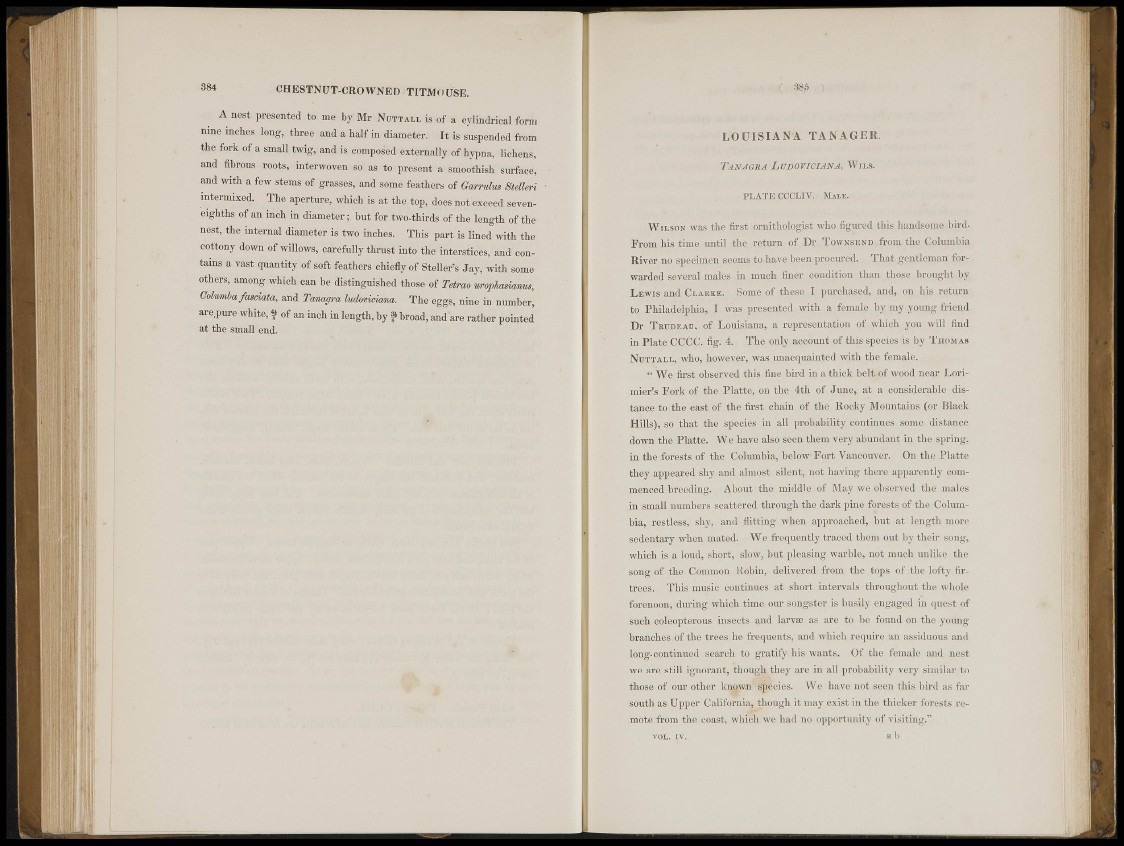
384 CHESTNUT-CROWNED TITMOUSE.
A »asti presented to me by Mr Nuttau. Is of » cylindrical forn.
nine, inches long, three a d , half ii, diameter. It is suspended from
the fork ||| a small twig, and is composed externally of hypna, licMhs,
and fibrous roots, interwoven so as to present a smoothish (curiae..,
and " i t l i a few sterns of grasses, tod some feathers of Gmlu* Sullen
intermixed, 'l'ho aperture, which ijj:m the to]., does not exceed seveneighths
of an inch: in diameter ; but for two. thirds of the length of the
nest, the internal diameter is two inches: Tins part is lined with thè
cottony down of willows, carefully thrust into the interstices, and contains
a vast quantity of soft feathers chiefly of Stealer's Jay; with some
others, among which'.ean be distinguished thosoW Tetmo mphmimus,
Columf,a fasciata, and Tanagra mwicfam. The eggs, nine in number,
are,pure white, f of an inch in length, b y ? broad, and are rather pointed
at the small end.
L O U I S I A N A TANA6EK.
TAXJcitJ I.i;j)Ovrt:ijMA, \Vn.s.
Wilson way the first ornithologist who figured this handsome birdl'rom
his time until the return of D® TOwnsend from the Columbia
Rive® no specimen seents to have been procured. That gentleman forwarded
several- males in much liner cjjmdition than tho.se brought, by
I.kwis and Ci.arkk. Sompof these. I purchased,: and, on his return
to Philadelphia, I was presented, with a female li.v my young friend
Dr TRi iiKAii, of Louisiana, a representation of which you will find
in Plate OCCC. fig, 4- The only account of this species is: by Thomas
NtrTTAi.i., whtfehowever, was unacquainted with the female.
" We first observed this fine bird/in a thick belt of wood near|||orimier's
For t of the Platte, on the 4th of J unc, at a considerable distaffieg
to the east; of the first chain of jfce Rocky Mountains (or Black
Bills), so that the species in I S probability continues some distance
down the I'latto. We have also-seen them very abundant in the,spring,
in the forests of the Columbia, below Fort Vancouver. On the Platte
they appeared shy and almost silent, not having there apparently commenced.
breeding. About the middle of May we observed the males
in small numbers scattered through the dark pine forests of tin! Columbia,
restless, shy. and flitting when approached, but at length more
sedentary when! mated. We frequently traced them out by their song,
which is a loud, short, slow, but pleasing warble, not much unlike the
song of the Common Kobin, delivered from >th.e^tops of the lofty lir
trees,. This music continues at short, intervals throughout the whole
forenoon, during which time our songster is busily engaged in quest of
such coleopterous insects and larvae as are to be found on the young
branches of the trees he frequents, and which require an assiduous and
long-continued search to gratify his wants. Of the -female and nest
we are still ignorant, though, they are in all probability very similar to
those of our other knovv.n sjieeies, We have not seen this bird as far
south as Upper California, though it may exist in the thicker forests remote
from the coast, which we had no opportunity of visiting."
VOL. IV. b b